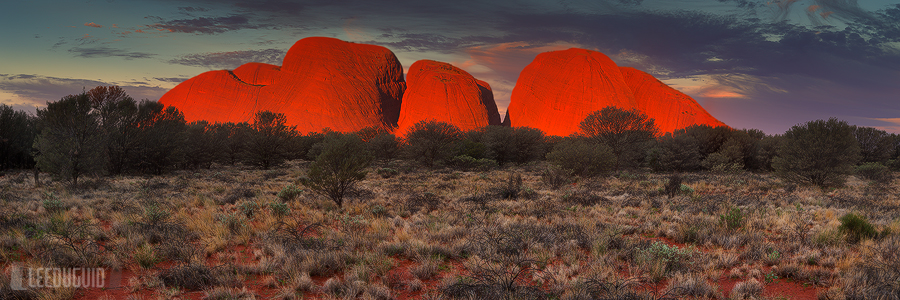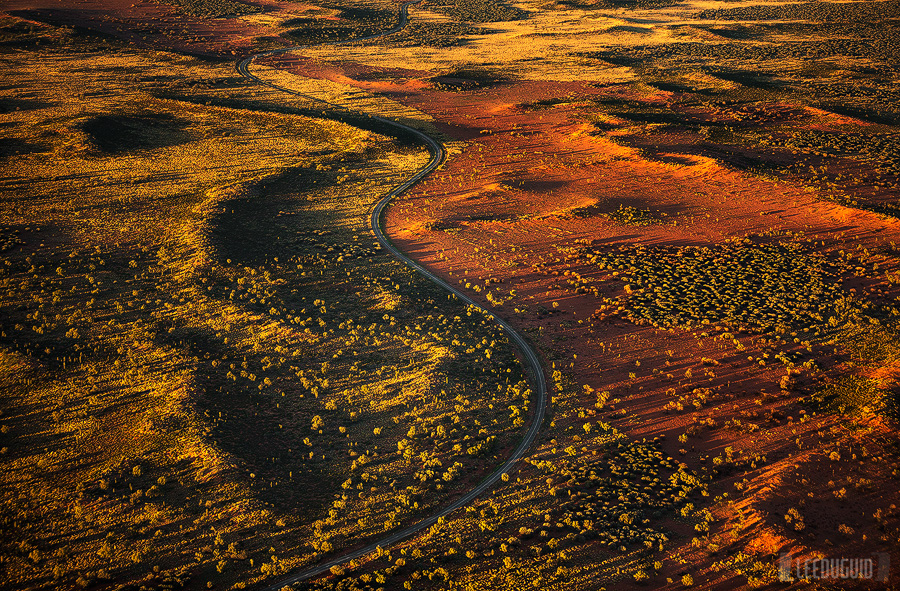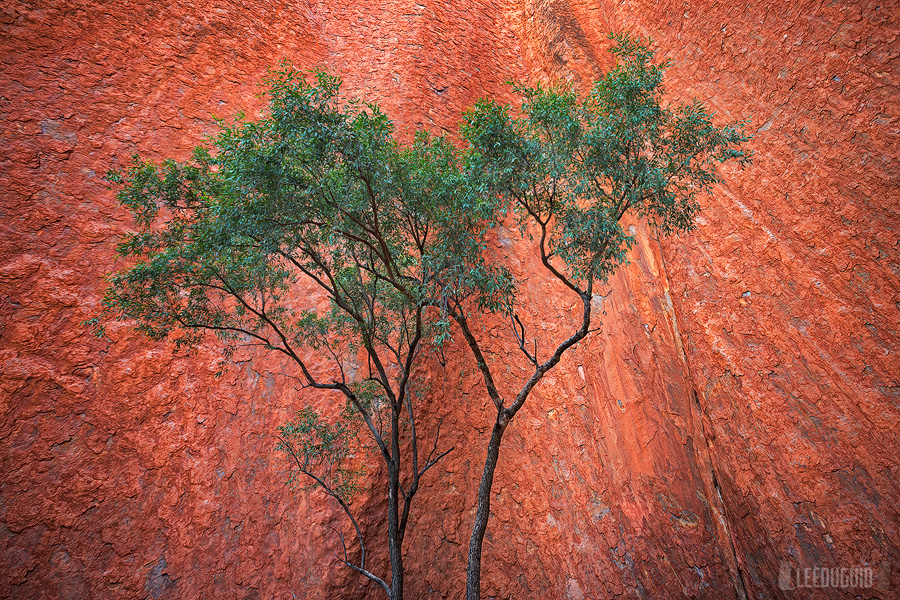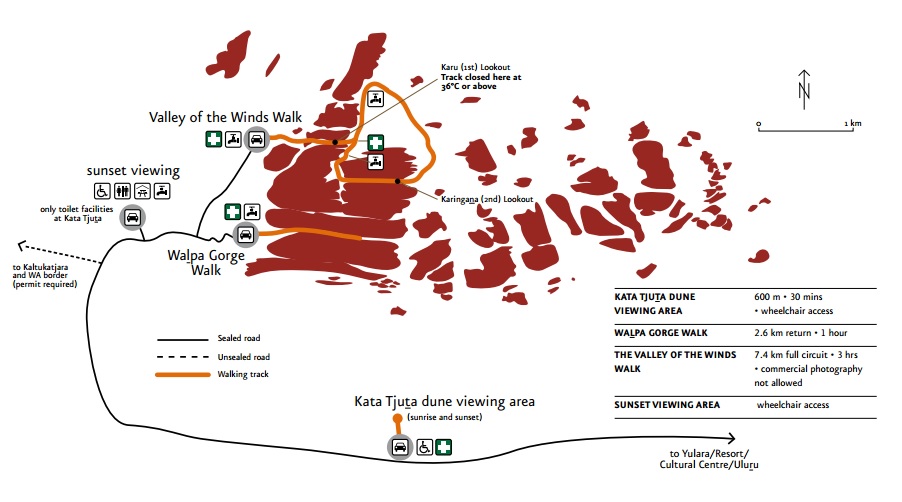In the heart of Australia Uluru-Kata Tjuta National Park is a location of both cultural significance (NESCO World Heritage site) and unique beauty. It’s red rust stained earth, gigantic monolith rock formations, and spectacular natural light shows will ensure visitors don’t leave disappointed.

Kata Tjuta, photographed from sunset viewing area
Special Photographic Features or Notes
Uluru (Ayers Rock)
Well Uluru of course, but where is best to shoot from? For the most part photographers and tourists alike are encouraged to photograph from either the sunset or sunrise viewing platforms (not literally a platform however there are platforms there). Both of the viewing platforms are positioned to capture the red glow of the rock as the last or first rays of light give it an amazing glow (pending weather). For the most part these locations offer great views of Uluru, all of the sunrise and sunsets shots in this post were taken from them. However to differentiate your photos and to find more foreground interest (which can be lacking), I suggest spending a couple of hours exploring the surrounding area to find a composition you are happy with. Alternatively shoot Uluru as a silhouette, and avoid the crowds by going to the opposite platform (shoot from the sunset viewing platform at sunrise).
Photographing from either of these sites or in direct line of sight is safe in that the culturally significant sites are somewhat obscured (unless you zoom in). More on what you can and can’t be commercially photographed below.
Whilst driving around there are limited places on the road where you can stop so you may have to walk a bit to find suitable locations. The parks people are very protective of the environment (as are most national parks) so you can’t just walk anywhere you want. Stick to the road, paths and don’t step over the barriers. The area is quite scrubby so finding clean and unobstructed views can be hard.
Kata Tjuta (The Ulgas)
Kata Tjutu is equally impressive as Uluru if not more so. As with Uluru photography is encouraged at the specific viewing points and stepping over barriers or roaming off track is not allowed. Again the foreground isn’t necessarily the best for my style of photography so I would recommend taking sometime to find suitable compositions close by. That’s not to say you won’t get good images from these locations, it’s just if you have the luxury of time you might want to explore specific locations to shoot from. I didn’t have time as I was travelling in a group so all the photos you see are shot from the viewing platforms.
Valley of the Winds
An amazing and highly recommended walk. I did the entire loop walk, which took less than the recommended 3 hours even at a leisurely pace. The second section (after the lookout) is how I imagine the Africa Savanna to look like. However I’m not sure how green it is at different times of the year. This landscape can vary massively with a bit of rain.
Commercial photography is heavily restricted here with many rules to abide by (see Commercial Photography section below).
Night Photography
The park closes at night so opportunities for photography are limited. Opening times vary throughout the year, more information can be found here. Uluru can still be viewed from outside of the National Park and there are other opportunities in the surrounding areas.
Aerial Photography
Chartering a helicopter can workout cheaper than buying joy rides when split among a few of you. It’s still not cheap by any standard but is well worth the investment. With a chartered helicopter you are in full control (not literally) of where the pilot flys, so you can get them to hover and maneuver into the perfect position for your photos.
Care must be taken to keep your shutter speed fast. You may think you are going reasonably slow from the air, however the relative ground speed can be hundreds of kilometers an hour. Not so great for getting sharp images.
The helicopter I flew in had huge windows allowing almost completely unrestricted photography. It also meant we could fly faster than if the doors were taken off saving flight time and therefor money.

Aerial Uluru, photographed from helicopter
Special Equipment
A fly net is a must in this region. Tolerance of ‘fly’s in your face all the time’ varies from person to person however I suggest carrying a fly net in case they become unbearable. The level of ‘fly’s in your face all the time’ is minimal before sunrise.
Best Time to Shoot
As far as time of day it goes without saying sunset and sunrise are the best times to shoot.
This region is semi arid and receives less that 250mm or rain per year. It experiences very hot temperatures (up to 45C) in the summer down to pretty cold temperatures (towards 0C) in the winter. For this reason it is best to visit this area either in Spring (September, October) or Autumn (April, May) where the temperatures are much more bearable.
Note in the height of summer (December, January) it can get hot enough that the walks are actually closed during the hottest parts of the day. Ignoring this and heading out unprepared is extremely dangerous and can result in death, so be warned.

Kantju Gorge Uluru Kata Tjuta National Park
Getting there
Flights now go direct to Ayers Rock Airport with the National Park only a 10 minute drive away. Accommodation and the town sit between the two. Alternatively you can fly to Alice Springs which is almost 500km drive away. If you have the luxury of time (10 days) I would fly to Alice Springs, get a camper-van, stock up with fuel and food then drive to Uluru via MacDonnell ranges, and Kings Canyon.
Commercial Photography
Because of the areas cultural significance commercially photographing this region is tightly controlled by the parks media office. For some reason this has left photographers with the impression that they have to bend the rules or run and hide when taking photographs here. In my experience this was not the case. In fact it was great to photograph this location with confidence knowing I had done the right thing and obtained a media pass.
Just to be clear, if you are an amateur photographer and have no intent on selling your images (prints, stock etc.) or using them to promote your business (Facebook, website etc.) then you are free to photograph this area without a permit.
Permits can be obtained through the Media Office simply by filling in an application form. There is a guide to help you along, fill it in as best you can and the Media office will phone you if there are any issues. As with most things I left this all to the last minute. I presume depending on the workload this might be an issue at some times of the year however I found them very prompt in answering my questions and following up on any of their needs.
As the permit includes park entry fees and a photographers assistant (must be declared when applying for the pass) it actually worked out cheaper than buying multi-day entry pass for two people. So there you go, no excuses now.
On arrival you pick up the pass at the parks gates. Photography is restricted to specific areas which are clearly marked in the guidelines.








[…] Location Guide – Uluru-Kata Tjuta National Park (Ayers Rock – Ulgas), Australia […]
Excellent work Lee
[…] Rock. There are also some important information that you must apply for when photographing and the following website will give you guidelines that are essential for you when visiting the Uluru […]
[…] Here is a link to where you can get the best shots ???? Link […]
The rules are beyond a bloody joke at the Rock…. you can’t shoot the North face at all which is the main attraction for most astro guys n gals, it is also very costly… a total waste of time considering it is a flaming rock and not a cemetary etc…. over ruled and over priced
Are tripods allowed at these locations? What about Field of Light location?
Yep, tripods are fine. I’m not sure about the Field of Light location but I would assume so.